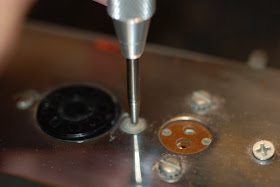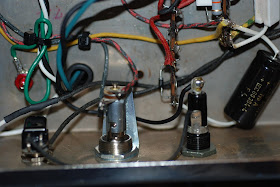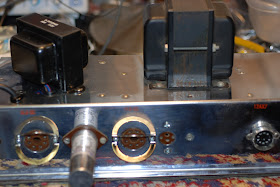Quite a number of amps have tube sockets that are riveted in. I can think of a lot of Ampegs for one, and a lot of Valco made amps, the Thunderclunker included.
It's quite simple for an old aircraft mechanic like me, but for those of you who are not used to this, do the following.
Use a spring loaded punch to put a small divot in the bucked head of the rivet-that's the round side.
Drill with a smallish drill so as to get a good pilot hole started. Then finish it off with a larger drill. I can't remember the sizes offhand but you can either punch out the rivet stem or use the butt end of a drill to snap the head off.
For tube sockets it's easier to make a little map of what goes where and then go ahead and cut the pins off with a pair of surface cutters. Then, once the new socket is installed clip the wires, strip them a little and reinstall.
Note the burned plastic on the old sockets.
them one by one.
Tuesday, October 4, 2016
Saturday, October 1, 2016
Reviving the Thunderclunker a/k/a Supro Thunderbolt Harmony 420
I've spent a couple of months on and off negotiating with a guy down south in Clarke County for a defunct Harmony 420, a/k/a the Thunderclunker. My reasons for doing so were because with the exception of a treble and a bass control it's the same as a Supro Thunderbolt of the later, no rectifier tube variety. There are both kinds, y'know.
A little research in the schematic library revealed that the Harmony 420, a couple of Airline amps, and the Supro are all pretty much identical to wit, two 12AX7s and a pair of 6L6GCs, cathode biased, nominally 35w (which I don't believe for a minute) and a Jensen C15P ceramic fifteen inch speaker.
UPDATE: I put this amp on the dummy load and it produced 37w maxed out. It was clean on the scope right up to 25w, which suggests that a nice JBL speaker would not be a bad thing. I have a couple in need of repair sooooo........
The amp was completely dead with no glass and no sign of life, so a complete-and I mean complete-rebuild was in order.
First to go were the tube sockets (burned and cracked), the Mallory can capacitor, and the taped in output transformer, the two way switch, neon lamp, fuse holder, dropping resistors and power supply diodes which got replaced with 1N4007s. The old ones tested OK but for about ten cents apiece I wasn't going to scrimp.
This is more or less what I found inside. It became a complete gut job of the power section.
Here's the pile of crap I removed.
And here's the finished product. The output transformer is a replacement for a Fender Vibrolux which I had. and the power transformer is original. About the only thing saved in the power section were the terminal strips. The fuse holder was broken so that went. The three way switch wasn't needed with the three conductor grounded cord, and I dumped the neon pilot light for a 6.3 volt Fender type lamp with a cool old vintage red jewel.
I measured up the finished voltages with a full complement of tubes and they are AC: 178 & 158 for a total of 336v, B+: 405vdc, Vscr 395, Vp 399 vdc, first preamp tube pin 1 244vdc, second preamp tube pin 1 219 vdc, pin 6 181 vdc, all of which are at reasonably healthy levels.
At the first power up all was well for a minute or two and then a heavy hum originating in the power section commenced to build to intolerable levels. After a minute's thought I remembered rassling with a Deluxe I used to have that did the same thing. It was as easy as isolating the transformer filament center tap and clipping a couple of 100 ohm 1/2 w resistors to the ends of the filament strings to beat some sense into this thing.
After some decent glassware was installed, the results were pretty serviceable with the original speaker doing its chores.
Remember that this amp is of the later type with a full wave bridge so there's no transformer high voltage center tap, despite what you may see on the schematics that are floating around. I'm thinking that obtaining a a replacement power transformer for the solid state rectified amps might be a chore, if one was to need one.
Here's a layout of the power section I did to keep track of things while taking frequent coffee breaks and doing domestic chores.
A little research in the schematic library revealed that the Harmony 420, a couple of Airline amps, and the Supro are all pretty much identical to wit, two 12AX7s and a pair of 6L6GCs, cathode biased, nominally 35w (which I don't believe for a minute) and a Jensen C15P ceramic fifteen inch speaker.
UPDATE: I put this amp on the dummy load and it produced 37w maxed out. It was clean on the scope right up to 25w, which suggests that a nice JBL speaker would not be a bad thing. I have a couple in need of repair sooooo........
The amp was completely dead with no glass and no sign of life, so a complete-and I mean complete-rebuild was in order.
First to go were the tube sockets (burned and cracked), the Mallory can capacitor, and the taped in output transformer, the two way switch, neon lamp, fuse holder, dropping resistors and power supply diodes which got replaced with 1N4007s. The old ones tested OK but for about ten cents apiece I wasn't going to scrimp.
This is more or less what I found inside. It became a complete gut job of the power section.
Here's the pile of crap I removed.
And here's the finished product. The output transformer is a replacement for a Fender Vibrolux which I had. and the power transformer is original. About the only thing saved in the power section were the terminal strips. The fuse holder was broken so that went. The three way switch wasn't needed with the three conductor grounded cord, and I dumped the neon pilot light for a 6.3 volt Fender type lamp with a cool old vintage red jewel.
I measured up the finished voltages with a full complement of tubes and they are AC: 178 & 158 for a total of 336v, B+: 405vdc, Vscr 395, Vp 399 vdc, first preamp tube pin 1 244vdc, second preamp tube pin 1 219 vdc, pin 6 181 vdc, all of which are at reasonably healthy levels.
At the first power up all was well for a minute or two and then a heavy hum originating in the power section commenced to build to intolerable levels. After a minute's thought I remembered rassling with a Deluxe I used to have that did the same thing. It was as easy as isolating the transformer filament center tap and clipping a couple of 100 ohm 1/2 w resistors to the ends of the filament strings to beat some sense into this thing.
After some decent glassware was installed, the results were pretty serviceable with the original speaker doing its chores.
Remember that this amp is of the later type with a full wave bridge so there's no transformer high voltage center tap, despite what you may see on the schematics that are floating around. I'm thinking that obtaining a a replacement power transformer for the solid state rectified amps might be a chore, if one was to need one.
Here's a layout of the power section I did to keep track of things while taking frequent coffee breaks and doing domestic chores.












